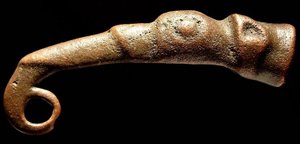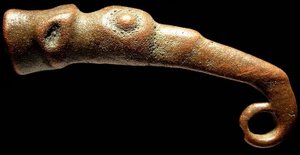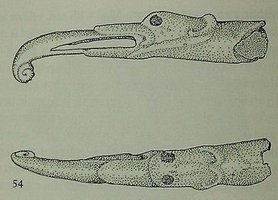A Viking Age Anglo Scandinavian drinking horn finial.
From status symbol to symbol for vanity and luxury - showing the temptation of Christ.
This article I like to take you on a trip alongside one of the distinct Viking Age attributes of noble descent, the drinking horn.
Being very rare, and within itself, being of a very rare type, I was extremely happy to be able to add this drinking horn finial to my collection. Just known to have been found in England, the salesman addressed it stylistically to the 11th century. The use of the kind of zoomorphic head in the finial resembles the casting of zoomorphic heads on stirrup finials of the 11th century.
The best/safest way to address this finial is Anglo Scandinavian from the (late) Viking Age. The long 'snout' resembles the Urnes like style of the snouts used and casted in that particular late Viking art style, but the crudiness of the way of casting makes this a hybrid Anglo Scandinavian form, as also can be recognised in other Anglo Scandinavian artefacts found in England from the 11th century (like stirrup terminals - see link).
The salesman thought the zoomorphic head to be a wolf. Stephen Pollington thought of it of being a canin. So.. zoomorphic indeed, as e sees something else in it. Only a few complete horns of the Viking Age did survive. Some more rim mounts and terminals survived but all in all these are rare items within the Viking Age artefacts segment.
The form of this drinking horn finial is definitely to be recognised already in the Anglo Saxon period. A magnificant pair of horns was excavated from the pagan burial mount of Taplow in England, dating from the 6th century. The horn found at the excavation at Sutton Hoo in 1939 adding to these early treasures of Anglo Saxon art.
A symbol of certain status..
The organisation of the symbel, based partly on the first party feasting scene in Beowulf also recalls the use of the horn. The drink should be offered in a splendid drinking horn, rather than a normal cup or beaker: horns were a status symbol at public events. Furthermore during the symbel, the circulation of the horn cannot end until the horn comes to rest. While individuals may excuse themselves and leave when they have had enough to drink, it is an act of great disrespect for any participant to lay down the drinking horn.
Viking Age mythology and tales from the Sagas have lots of references to drinking horns. Often included in the descriptions of large banquets, they also have a symbolic value as an official gesture of welcome. Think about the Valkyries, welcoming the fallen warriors with a drinking horn to Walhalla.
The famous 'Fyrkat woman' grave, contained two drinking horns. Neil S. Price has suggested that it might be the grave of a Viking sorceress, a so called völve, similar to graves in Sweden. As her grave was the richest burial in the cemetery, she must have been of considerable social standing. In Scandinavia six horns have been found in Birka in Sweden and tenty-six horns - some of them in pairs - have been found in Norway.
Two remarkable dragonheads of bronze, probably decorating the tips of two drinking horns are in the National Museum of Denmark. Both can be dated around 1050 A.D. one in very distinct Urnes style with a long elegant head.
Also in present day Ukrain a pair of (complete) drinking horns was found in the so called 'Black Grave' in the area of the Kievan-Rus.
The Bayeux tapestry depicts a banquet at Bosham with King Harold and his Anglo-Saxon peers. Two large drinking horns with mounts at rim and elobarate tips are also tokens of the high status posession and use. Finally, the great Norman font in St. Mary's church in Burnham Deepdale is decorated with reliefs showing symbols of the farming calendar. January is symbolized by a man sitting in a chair and drinking from a large drinking horn.
Perhaps the sene is somehow reflected in the wooden calendar sticks - known from the later medieval Scandinavia - on wich the Adoration of the Magi (the 6th January) was marked with a drinking horn.
'From this horn it is thought to be well drunk if it is emptied in one drought, some men empty it in two draughts, but there is no drinker so wretched that he cannot exhaust it in three..'
the testing by Thor of the evil giant Utgard-Loke of Jotunheim
From Ireland a horn terminal excavated at Carraig Aille - see images beneath - has openwork jaws wich enclose a stout ring (like mine) probably for a suspension strap. Being from the 8th century, it is some centuries older though than the A-S example. Another horn terminal from Ireland has blue inlay garnets and an - unprovenanced - drinking horn terminal decorated in the Irish/Ringerike style of Viking art with remaining glass settings and remains of silver wire inlay pays tribute to the luxurious nature of several horn terminals. The article, written by James Graham-Campbell I have attached the reference at the end of this blog.
To my knowledge, my drinking horn no other similar/similarlike type is known, but correct me if I am wrong.
So, what went wrong for the drinking horn during the (early medieval) centuries ?
It seems to be that the christianisation was guilty of this. As these days, Islamic State has some very determinated ideas - to put it utterly mildly - of what is to be and what isn't to be anymore, the Anglo-Saxon church had their owns..
Already in 787 A.D. a synod of the Englisch church met at Chelsea, and the proceedings included a special canon about the proper behaviour of priests celebrating mass. 'We have also ruled that neither the chalice nor the paten for the offering of God should be made of oxhorn, because they are bloody'. Of course, this was double-Dutch for stigmatising the drinking horn for being of evil sin.
Drinking horns were used to illustrate a wasteful living, by the church gradually becaming a symbol of vanity and lust. An illustration in a manuscript from the end of the 9th century shows Luxuria, personified by a young woman, who is offered drinking horns by three men. The Latin text states: "Now Luxuria defeats sobriety".
The image is getting worse, though. In an Anglo-Saxon manuscript from the 11th century - the so-called Tiberius Psalter - shows a picture of the third temptation of Christ. (how many times can Christ have been tempted anyway ? whas it that tempting, and for who ? The tempter or Christ ? ;)
Just beside the figure of Satan is a drinking horn among other items, which evidently all symblozes earthly wealth and vanity.
One of the last items reflecting the high culture at court use of the drinking horn can be seen in one of the 12th century dating figures of the Lewis chessmen.
During the next 100 years the old traditions for the use of drinking horns dissapeared, but at the end of the 13th century the use was rediscovered. After all... who doens't like a drinking horn as one sees nowadays the often reproduction of early medieval drinking horns on the internet.
So, finally, what for the Anglo-Scandinavian drinking horn finial mount..
Who had been using it ? It wouldn't have been someone of lower social status.
When was it finally lost or gotten out of use ? And if gotten out of use, for what reason ?
These tantalizing questions remain in the mist...
References:
Etting, V., The story of the drinking horn - drinking culture in Scandinavia during the Middle Ages (2013);
Graham-Campbell, J., An eleventh-century Irish Drinking-horn Terminal, Tapir Academic Press (2008)
Pollington, S., The Mead-Hall - Feasting in Anglo-Saxon England (2003);
Youngs, S., The work of angels - Masterpieces of Celtic Metalwork, 6th-9th centuries A.D. (1989).
Well. I could have been with these stones until after dark, but as my wife wanted to travel on.. well.. I see you again, some day, hogback stones from Gosforth. And if you happen to be there one day, do not forget that monument on the outside...
Further on with the Cumbrian hogbacktour !
In - yes, luckily again in - St. Peter's church in Heysham, there is a truly beautiful hogback stone. The guide told us, it had been studyied by Thor Ewing, a writer, in 2000. in 'Understanding the Heysham hogback' A tenth century sculpted stone monument and its context (link), Thor Ewing tells in detail what he dicovered on the both sides of this hogback stone.
Just being brought in the church as late as the 1970's accompanied with some protest here and there among the church visitors, considered as being a token of old paganism, it had been remarkably nice preserved, and a lot of detail can be seen, still. Truly worthwile a visit.
I had a small debate with the guide in the church if the - zoomorphic, in my opinion - faces on the sides were lions (or hippo's). The guide doubted if the vikings could have known about lions. Well I guess so, concerning the runes on the Ancient Greek lion statue at the Arsenal, Venice. For example. Vikings did travel south..
But when he told me he was doubting the vikings 'discovered' (as the native inhabitants were of course, in the first place) America before Columbus, I decided to rest my case..
One has to know when to start and to end a conversation ..
Just discovered the book in a bookstore written by Geoff Holder - The guide to the mysterious Lake District, I knew there had to be another hogback stone in Lowther, St. Micheal's Church. With a promising image described in the text of 'a naval and a land-based force of shield-bearing vikings above a fish and what might be a coiled sea serpent. On the reverse is a row of female figures with snakes, possibly a representation of the hideous hag Hel'. Wow. If that did not sound as a true pagan promised land ..
Not complaing too much after all we have seen, this visit was the dissapointing one of them all. But if you wife states 'I am happy to have seen them' and I am answering 'Measuring is knowing' and the even more obligate verb 'handling 'if we did not see it at all, we wouldn't have known anything at all of how they were looking' the glass was again half full, at the last day of our journey..
The hogback stone appeared to be just being tolerated within the entrance segment part of the church. As something you never use anymore but you do not throw away - entirely. That sort of feeling emerged when seeing this hogback asylum seekers.. Bed, bath and bread, ás we say in Dutch, but no luxury at all and standing on some outcuts of wood, you would balance the table with at home..
Come on, St. Micheal's Church.. care a bit more of your 'children' !
This hogback stone was moved in the church in 1907. Hogback stones layed partially buried in the churchyard before it was dug up and moved into the church.
The promising depiction of a longship - as certainly can be seen after some studying - see http://vikingminds.co.uk/pages/longship
we have missed !
The stone itself is (157 x 50 x 30 cm) and very worn.
The hogback stones in Cumbria - very diverse in quality, but everyone worth a visit ! Especially on a gloomy day in late October ...
The churches to visit - see photos of resp. St. Andrew's church in Penrith, St. Mary's church in Gosforth, St. Peter's church in Heysham and St. Micheal's church in Lowther.
Did I miss out on another one in Cumbria ? Let me know !
In a next blog I will take you to four - still remaining utterly mysterious- statues 'guarding' the graveyard of St. Andrew's church in Dacre..
For the last blog of October 9th see this link.
References: (as always, links to where the books can be ordered are attached).
Edwards, B.J.N. Vikings in North West England - The artifacts (1998);
Emery, Gordon, CURIOUS CUMBRIA, The Lake District & Beyond: A celebration of Cumbria (2023)
Ewing, T. 'Understanding the Heysham hogback' A tenth century sculpted stone monument and its context ;
Hall, R. Viking Age archaeology in Britain and Ireland (first printed 1990, reprinted with amendments in 1995);
Holder, G. The guide to the mysterious Lake District (2009)
possibly also (as there within the part of Cumbria dealing with Carlisle, the Eden Valley, Barrow-in-Furness, Whitehaven and the west coast is being dealed with)
Holder, G. Paranormal Cumbria (2010)
http://vikingminds.co.uk/pages/longship



